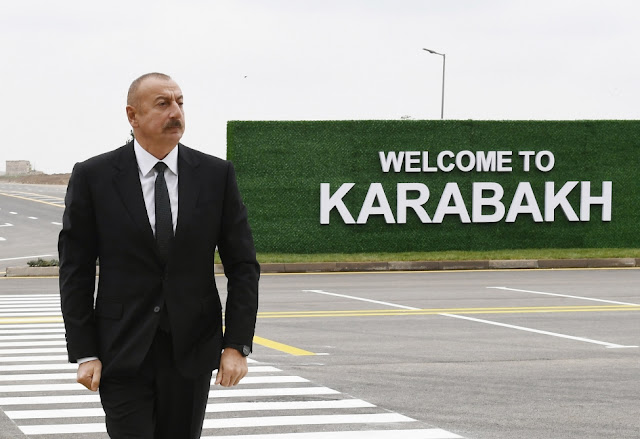Karabakh, the recently freed region from occupation, now faces the challenge of rebuilding its economy and ensuring sustainable growth for its people. One potential solution lies in implementing an economic growth model tailored specifically to Karabakh's unique circumstances.
To begin with, it is important to assess the current economic situation in Karabakh. Years of conflict and occupation have left the region devastated, with infrastructure in ruins and a high number of internally displaced persons (IDPs) who have lost their homes and livelihoods. The priority must be on creating new opportunities for these IDPs while also attracting investment and fostering entrepreneurship.
The economic growth model for Karabakh should focus on several key areas. There needs to be a strong emphasis on diversifying the economy beyond traditional sectors such as agriculture. This could involve promoting industries like tourism, technology, and renewable energy that can provide much-needed jobs and generate revenue.
Investing in education and skills training is crucial for ensuring that the local workforce is equipped with the necessary knowledge to participate effectively in emerging sectors. This would not only enhance productivity but also attract investors looking for a skilled labor force.
Furthermore, infrastructure development plays a vital role in enabling economic growth. Improving transportation networks, communication systems, and access to basic services will create an environment conducive to business expansion while improving living standards for residents.
In addition to these measures, it is essential to prioritize social welfare programs that support vulnerable groups such as refugees who have been affected by years of conflict. By providing them with adequate housing assistance, healthcare services, and educational opportunities, they can become active participants in Karabakh's economic revival rather than being left behind.
Implementing this economic grow model tailored specifically to Karabakh's needs has multiple benefits. It will lead to job creation at various skill levels which will help alleviate poverty rates among IDPs and other marginalized communities. Increased foreign direct investment will boost capital inflows into the region, stimulating economic activity and providing resources for further development.
The benefits of implementing an economic growth model in Karabakh are vast and far-reaching. It would provide a solid foundation for the region to rebuild its shattered economy after years of occupation and conflict.
By focusing on economic growth, Karabakh can attract investment from both domestic and international sources. This influx of capital would not only create job opportunities for the local population but also stimulate entrepreneurship and innovation.
Additionally, an economic growth model would enable Karabakh to diversify its industries beyond traditional sectors like agriculture. By embracing new technologies and encouraging sectoral development, the region can tap into emerging markets and capitalize on global trends.
Furthermore, sustained economic growth would improve living standards for the people of Karabakh. It would lead to increased access to healthcare services, education facilities, and infrastructure development. This improved quality of life would foster social stability and cohesion within the community.
Moreover, by adopting an economic growth model that prioritizes sustainability and environmental responsibility; Karabakh can preserve its natural resources while still reaping the benefits of development.
Implementing an economic grow model in Karabakh holds immense potential for revitalizing the region's economy, creating employment opportunities, improving living standards, fostering innovation & entrepreneurship whilst preserving the environment. It is a crucial step towards building a prosperous future for this freed region from occupation.
The economic growth model holds great potential for revitalizing Karabakh and fostering its development as a thriving region after years of occupation. By implementing strategic policies that prioritize investment, infrastructure development, and job creation, Karabakh can attract both domestic and foreign investors, stimulate various sectors of the economy, and provide opportunities for its displaced population.
The liberation of Karabakh from occupation presents a unique opportunity to rebuild not only physical structures but also social cohesion and unity among its people. Through education initiatives that focus on skills training and entrepreneurship programs, the region can empower its citizens to actively participate in shaping their own future.
It is important for international organizations, neighboring countries, as well as the global community to come together in supporting the economic growth model for Karabakh. By offering financial aid, technical expertise, and diplomatic support during this critical transition period, we can collectively contribute to establishing stability in the region while ensuring sustainable economic progress.
Let us envision a prosperous future for Karabakh where refugees are resettled with dignity and have access to equal opportunities. The implementation of an inclusive economic growth model will not only bring tangible benefits such as increased employment rates and GDP growth but also foster reconciliation among communities torn apart by conflict.
Karabakh's journey towards economic recovery will require time, dedication, collaboration between various stakeholders including government agencies at different levels (local authorities), private sector actors (businesses), civil society organizations (NGOs) - all working hand in hand towards shared prosperity.
As we reflect on past challenges faced by this resilient region with hope in our hearts let us continue supporting efforts aimed at creating a brighter future for all who call Karabakh home!

Comments
Post a Comment